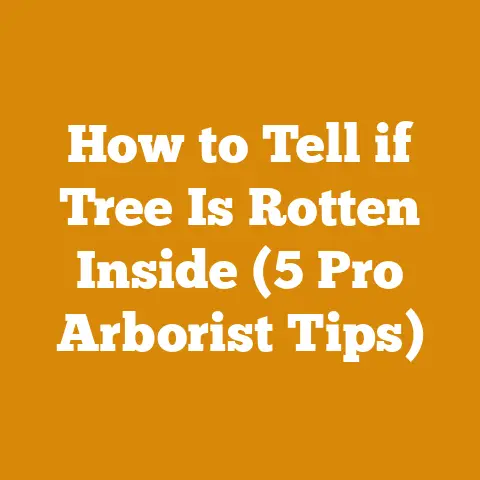Natural Fire Starter Tips (5 Proven Wood Chip Hacks)
Okay, let’s dive into the world of natural fire starters, specifically using wood chips. I’ve spent years in the woods, from felling trees to processing firewood, and I can tell you, a reliable fire starter is worth its weight in gold. I’ll share my proven wood chip hacks to get your fires roaring quickly and efficiently.
Natural Fire Starter Tips: 5 Proven Wood Chip Hacks
Upgrading your fire-starting game isn’t just about convenience; it’s about efficiency, safety, and resourcefulness. Think about it: how many times have you struggled to light a fire in damp conditions, wasting matches and kindling? Or perhaps you’ve relied on chemical-laden fire starters that pollute the air and leave a lingering odor?
My journey into mastering natural fire starters began out of necessity. I was working on a remote logging project in the Pacific Northwest, where the weather was notoriously unpredictable. We needed reliable fires for cooking, warmth, and drying out gear. Store-bought fire starters were expensive and bulky, so I started experimenting with what we had readily available: wood chips, sawdust, and natural resins. Over time, I developed a set of techniques that not only worked but also utilized waste materials from our logging operations.
These “upgrades” aren’t just about replacing one fire starter with another. They’re about understanding the principles of combustion, the properties of different types of wood, and how to harness these resources to create reliable and sustainable fire starters. It’s about moving from relying on external products to becoming self-sufficient in your fire-starting capabilities.
Let’s get started.
Understanding the Basics: Wood Chips and Fire
Before we jump into the hacks, let’s define some key terms and concepts. This will give you a solid foundation for understanding why these techniques work.
- Wood Chips: Small fragments of wood produced during various wood processing activities, like chipping branches, sawing logs, or even using a chainsaw.
- Kindling: Small, easily combustible materials used to start a fire. Wood chips can serve as excellent kindling.
- Tinder: Highly flammable material that catches a spark or flame easily, initiating the fire.
- Seasoned Wood: Wood that has been dried to a low moisture content (ideally below 20%). Seasoned wood burns much more efficiently than green wood.
- Green Wood: Freshly cut wood with a high moisture content. Green wood is difficult to ignite and burns poorly.
- Resin/Pitch: A sticky, flammable substance found in coniferous trees (pines, firs, spruces). Resin is an excellent natural fire starter.
- Combustion: The process of burning, which requires fuel (wood), oxygen, and heat.
Why Wood Chips?
Wood chips, often considered waste, are actually a fantastic resource for fire starting. Their small size and high surface area make them easy to ignite. When properly prepared, they can provide a consistent and reliable flame to get your larger kindling burning.
Hack #1: The Pine Resin Booster
This is my go-to method, especially when dealing with damp conditions. Pine resin, also known as pitch, is incredibly flammable and acts as a powerful accelerant.
Materials:
- Wood chips (preferably from softwood like pine or fir)
- Pine resin (collected from pine trees or purchased in chunks)
- Small pot or container
- Heat source (camp stove, hot plate, or even a controlled campfire)
- Tongs or stirring stick
- Optional: Wax paper or molds
Step-by-Step Guide:
- Collect Pine Resin: The best time to collect pine resin is during warmer months when it’s more pliable. Look for areas where the tree has been damaged, as resin will often seep out to protect the wound. You can also find hardened resin on the ground beneath pine trees. Be mindful of the environment and only take what you need.
- Melt the Resin: Place the pine resin in a small pot or container and gently heat it over a low heat source. Avoid direct flame, as resin is highly flammable and can easily ignite. Stir the resin occasionally to ensure it melts evenly. I prefer to use a double boiler setup to prevent scorching.
- Infuse the Wood Chips: Once the resin is completely melted and has the consistency of honey, carefully add the wood chips to the pot. Use tongs or a stirring stick to coat the wood chips thoroughly with the melted resin. Ensure that each chip is well saturated.
- Cool and Solidify: Remove the pot from the heat and spread the resin-coated wood chips on wax paper or pour them into small molds (like ice cube trays). Allow the resin to cool and solidify completely. This may take several hours, depending on the temperature.
- Store and Use: Once the resin-coated wood chips are solid, store them in an airtight container to prevent them from becoming sticky or attracting insects. To use, simply place a few chips under your kindling and light them with a match or lighter. The resin will ignite quickly and provide a strong, sustained flame.
Pro Tips & Insights:
- Wood Type: Softwood chips from pine, fir, or spruce work best because they are more porous and absorb the resin better.
- Resin Quality: The higher the resin content, the more effective the fire starter. Look for resin that is clear and fragrant.
- Safety: Always exercise caution when working with melted resin. Wear gloves and eye protection to prevent burns.
- Customization: You can add other flammable materials to the mixture, such as dried pine needles or cotton lint, to enhance its flammability.
Case Study:
During a winter camping trip in the Cascade Mountains, I encountered extremely wet conditions. Even seasoned firewood was proving difficult to ignite. I remembered I had a bag of pine resin-infused wood chips I’d prepared beforehand. Just a few of these chips under some damp kindling created a flame strong enough to dry out the wood and get the fire going. It was a lifesaver!
Hack #2: The Waxed Wood Chip Briquette
This method creates a long-lasting and waterproof fire starter that is perfect for backpacking or emergency kits.
Materials:
- Wood chips (any type will work, but softwood is still preferred)
- Paraffin wax (scraps from old candles or purchased in bulk)
- Cardboard egg carton or muffin tin
- Double boiler or pot and heat-resistant bowl
- Tongs or stirring stick
- Optional: Dryer lint or cotton balls
Step-by-Step Guide:
- Prepare the Mold: Line a cardboard egg carton or muffin tin with wax paper to prevent the briquettes from sticking.
- Melt the Wax: Fill the bottom of a double boiler with water and bring it to a simmer. Place the paraffin wax in the top pot or heat-resistant bowl and allow it to melt completely. Stir occasionally to ensure even melting.
- Combine Wood Chips and Wax: Once the wax is melted, carefully add the wood chips to the pot. Use tongs or a stirring stick to coat the wood chips thoroughly with the melted wax. If you’re using dryer lint or cotton balls, add them to the mixture as well.
- Pour into Molds: Carefully pour the wax-coated wood chip mixture into the prepared molds. Fill each compartment to the top.
- Cool and Harden: Allow the briquettes to cool and harden completely. This may take several hours. You can speed up the process by placing them in the refrigerator.
- Remove from Molds: Once the briquettes are solid, remove them from the molds. They should be firm and waterproof.
- Store and Use: Store the waxed wood chip briquettes in an airtight container or plastic bag to prevent them from melting in warm weather. To use, simply light one of the briquettes with a match or lighter. The wax will burn slowly and steadily, providing a long-lasting flame to ignite your kindling.
Pro Tips & Insights:
- Wax Type: Paraffin wax is the most common choice, but you can also use beeswax or soy wax. Beeswax has a pleasant scent and is more natural, but it’s also more expensive.
- Wax Ratio: The ideal ratio of wood chips to wax is about 2:1 by volume. This ensures that the wood chips are well saturated with wax but not overly bulky.
- Coloring: You can add candle dye to the wax to give the briquettes a vibrant color.
- Waterproofing: The wax coating makes these briquettes highly waterproof, making them ideal for wet conditions.
Case Study:
I once participated in a survival skills workshop where we had to build a fire using only natural materials. Several participants struggled to get their fires going due to damp conditions. I pulled out a waxed wood chip briquette from my kit, and it ignited almost instantly, providing a strong flame that quickly dried out the surrounding kindling. The instructor was impressed!
Hack #3: The Sawdust and Oil Cake
This method utilizes fine sawdust and vegetable oil to create a compact and slow-burning fire starter.
Materials:
- Fine sawdust (from any type of wood)
- Vegetable oil (any type will work, but canola or sunflower oil is preferred)
- Cardboard tubes (toilet paper rolls or paper towel rolls)
- Wax paper
- Optional: Dried herbs or spices (for added scent)
Step-by-Step Guide:
- Prepare the Sawdust Mixture: In a bowl, combine the sawdust and vegetable oil. The ratio should be about 3:1 by volume. Mix thoroughly until the sawdust is completely saturated with oil. The mixture should have the consistency of damp sand.
- Pack the Tubes: Line the inside of a cardboard tube with wax paper. This will prevent the sawdust mixture from sticking to the tube. Pack the sawdust mixture tightly into the tube, compressing it as much as possible.
- Wrap and Seal: Once the tube is filled, wrap it tightly with wax paper, sealing the ends to prevent the sawdust mixture from drying out.
- Cut into Cakes: Using a sharp knife, cut the filled cardboard tube into individual cakes, about 1-2 inches thick.
- Store and Use: Store the sawdust and oil cakes in an airtight container or plastic bag. To use, simply light one of the cakes with a match or lighter. The oil-soaked sawdust will burn slowly and steadily, providing a long-lasting flame.
Pro Tips & Insights:
- Sawdust Fines: The finer the sawdust, the better the fire starter. Fine sawdust ignites more easily and burns more consistently.
- Oil Type: Vegetable oil is a safe and readily available option, but you can also use other types of oil, such as mineral oil or even used cooking oil.
- Compression: Compressing the sawdust mixture tightly into the tubes is crucial for creating a slow-burning fire starter.
- Scent: Adding dried herbs or spices to the sawdust mixture can give the cakes a pleasant scent when they burn.
Case Study:
I was working on a woodworking project in my shop and had a lot of fine sawdust left over. Instead of throwing it away, I decided to try making sawdust and oil cakes. I was amazed at how well they worked! They burned for a surprisingly long time and provided a reliable flame for starting my wood stove.
Hack #4: The Cotton and Petroleum Jelly Bomb
This is a classic fire starter that is incredibly easy to make and highly effective.
Materials:
- Cotton balls (100% cotton)
- Petroleum jelly (Vaseline)
- Airtight container or plastic bag
Step-by-Step Guide:
- Coat the Cotton Balls: Take a cotton ball and coat it thoroughly with petroleum jelly. Ensure that the entire cotton ball is covered in a thin layer of petroleum jelly.
- Repeat: Repeat the process for all the cotton balls.
- Store: Place the petroleum jelly-coated cotton balls in an airtight container or plastic bag.
- Use: To use, pull apart a cotton ball slightly to expose the dry cotton fibers. Light the cotton ball with a match or lighter. The petroleum jelly will burn slowly and steadily, providing a long-lasting flame.
Pro Tips & Insights:
- Cotton Type: Ensure that you are using 100% cotton balls. Synthetic cotton balls will not work as well.
- Petroleum Jelly Coating: A thin, even coating of petroleum jelly is ideal. Too much petroleum jelly can make the cotton ball difficult to ignite.
- Storage: Storing the cotton balls in an airtight container will prevent them from drying out and losing their flammability.
- Versatility: These fire starters are incredibly versatile and can be used in a variety of situations, from camping and backpacking to emergency preparedness.
Why include this hack?
While this hack doesn’t directly use wood chips, it’s an excellent addition to a fire-starting kit and can be used in conjunction with wood chip-based fire starters. For example, you can use a petroleum jelly cotton ball to ignite a pile of pine resin-infused wood chips.
Case Study:
I always keep a small bag of petroleum jelly cotton balls in my backpack when I go hiking. They are lightweight, easy to carry, and provide a reliable fire starter in any weather conditions. I once used one to start a fire in a snowstorm, and it worked perfectly.
Hack #5: The Birch Bark and Wood Chip Combination
This method utilizes the natural flammability of birch bark in combination with wood chips for a potent fire-starting duo.
Materials:
- Birch bark (collected sustainably from fallen trees)
- Wood chips (preferably from softwood)
- Knife or scissors
- Tinder (such as dried grass or leaves)
Step-by-Step Guide:
- Collect Birch Bark: Birch bark is naturally water-resistant and contains oils that make it highly flammable. Collect birch bark sustainably from fallen trees or branches. Avoid stripping bark from living trees, as this can harm them.
- Prepare the Birch Bark: Using a knife or scissors, shave thin strips of birch bark from the outer layers. The thinner the strips, the more easily they will ignite. You can also crumple the birch bark to create a fluffy tinder.
- Combine with Wood Chips: Place a small pile of tinder (dried grass or leaves) in the center of your fire pit or fire ring. Arrange the shaved birch bark strips on top of the tinder, creating a small teepee shape. Sprinkle the wood chips around the base of the birch bark teepee.
- Ignite: Light the tinder with a match or lighter. The birch bark will ignite quickly and provide a strong flame that will ignite the wood chips.
- Add Kindling: Once the wood chips are burning steadily, add larger pieces of kindling to the fire.
Pro Tips & Insights:
- Sustainable Harvesting: Always harvest birch bark sustainably. Only take what you need from fallen trees or branches.
- Birch Bark Preparation: The key to using birch bark effectively is to shave it into thin strips. This increases its surface area and makes it easier to ignite.
- Wood Chip Placement: Placing the wood chips around the base of the birch bark teepee will help to catch the embers and sustain the flame.
- Water Resistance: Birch bark is naturally water-resistant, making it an excellent fire starter in wet conditions.
Case Study:
During a wilderness survival course, I learned the importance of using natural resources for fire starting. Birch bark quickly became my favorite fire starter. I was amazed at how easily it ignited, even when damp. I’ve used it successfully in countless situations, from starting campfires to building survival fires.
Strategic Advantages of Using Natural Fire Starters
Beyond the practical “how-to,” let’s consider the strategic advantages of mastering these techniques:
- Cost Savings: No more buying expensive store-bought fire starters. You’re utilizing readily available resources.
- Environmental Responsibility: You’re reducing waste by repurposing wood chips and other natural materials.
- Self-Sufficiency: You’re becoming less reliant on external products and more capable of handling fire-starting challenges independently.
- Emergency Preparedness: You’re equipping yourself with essential skills for survival situations.
- Appreciation for Nature: You’re developing a deeper understanding and appreciation for the resources that nature provides.
Safety Considerations
- Fire Safety: Always practice fire safety when building and maintaining a fire. Clear a wide area around the fire pit, keep a water source nearby, and never leave a fire unattended.
- Material Handling: Exercise caution when working with flammable materials such as pine resin, wax, and oil. Wear gloves and eye protection to prevent burns.
- Environmental Responsibility: Be mindful of the environment when collecting natural materials. Only take what you need and avoid damaging living trees or plants.
- Ventilation: When melting wax or resin, ensure adequate ventilation to avoid inhaling harmful fumes.
Next Steps and Implementation Guidance
Ready to put these hacks into practice? Here are some practical next steps:
- Gather Your Materials: Start collecting wood chips, pine resin, wax, sawdust, and other natural materials.
- Experiment with Different Techniques: Try each of the five hacks and see which ones work best for you and your environment.
- Practice Your Skills: Practice starting fires in different conditions to build your confidence and proficiency.
- Build a Fire-Starting Kit: Assemble a small fire-starting kit with your favorite natural fire starters, matches, a lighter, and a knife.
- Share Your Knowledge: Share your knowledge with others and encourage them to adopt sustainable fire-starting practices.
Conclusion
Mastering the art of natural fire starting is a rewarding and empowering skill. By utilizing readily available resources like wood chips, pine resin, and birch bark, you can create reliable and sustainable fire starters that will serve you well in a variety of situations. Remember to practice safety, be mindful of the environment, and never stop learning. Happy fire starting!






